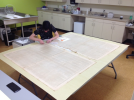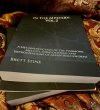jzucker
Experienced
FM9 using modified version of jeremey poparad's holdsworth preset but using an ODS and EV12L instead of the Mesa and 4x12
This is an example of how you can use the 2-1-2 legato style over arpeggios. In this case an AbMaj7#5 arpeggio. I frequently use this type of arpeggio starting on the 3rd of an altered dominant chord, in this case E7#9#5.
It's a pretty simple arpeggio pattern that you can apply to a ton of different arpeggios and pentatonic scales.
The AbMaj7#5 arpeggio (Ab, C, E, G) gives you the 3rd, #5, Root and #9 over the E7. The reason it sounds so cool is because we are boiling down the scale (in this case it comes from the F Melodic Minor scale) to it's essential juice notes.
Juice notes are where it's at for getting modern sounds.
#TimMiller
#sheetsofsound
#jazzguitarlessons #guitarlessons
#jazzguitar #modernjazzguitar #jazzguitarriffs
#KieselGuitar #fusionguitar #altereddominant
This is an example of how you can use the 2-1-2 legato style over arpeggios. In this case an AbMaj7#5 arpeggio. I frequently use this type of arpeggio starting on the 3rd of an altered dominant chord, in this case E7#9#5.
It's a pretty simple arpeggio pattern that you can apply to a ton of different arpeggios and pentatonic scales.
The AbMaj7#5 arpeggio (Ab, C, E, G) gives you the 3rd, #5, Root and #9 over the E7. The reason it sounds so cool is because we are boiling down the scale (in this case it comes from the F Melodic Minor scale) to it's essential juice notes.
Juice notes are where it's at for getting modern sounds.
#TimMiller
#sheetsofsound
#jazzguitarlessons #guitarlessons
#jazzguitar #modernjazzguitar #jazzguitarriffs
#KieselGuitar #fusionguitar #altereddominant




